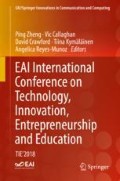Abstract
We explore the need for embedding creativity in the UK higher education computing curriculum and some of the challenges associated with this. We identify some of the initiatives and movements in this area and discuss some of the work that has been carried out. We then describe some of the ways we have tried to meet these challenges and reflect on our degree of success with respect to the goal of producing graduates who are fit for the myriad of job opportunities they will come across in a rapidly changing technology landscape. Finally, we make a number of recommendations.
Access this chapter
Tax calculation will be finalised at checkout
Purchases are for personal use only
References
D. Pink, A Whole New Mind: Why Right-Brainers Will Rule the Future (Riverhead Books, New York, 2006)
R. Capraro, S. Slough, Why PBL? Why STEM? Why now? An introduction to STEM project-based learning: an integrated science, technology, engineering, and mathematics approach, in STEM Project-Based Learning: An Integrated Science, Technology, Engineering, And Mathematics (STEM) Approach, ed. by M. Capraro, 2nd edn., (Sense Pub, Rotterdam, 2013)
E. Eisner, Artistry in education. Scand. J. Educ. Res. 47(3), 373–384 (2003)
P. Mishra, D. Henriksen, A. NEW, Approach to defining and measuring creativity: rethinking technology & creativity in the 21st century. The Deep-Play Research Group. TechTrends 57(5), 10–13 (2013)
S. Scoffham, J. Barnes, Happiness matters: towards a pedagogy of happiness and well-being. Curric. J. 22(4), 535–548 (2011)
D. Cropley, A. Cropley, Engineering creativity: a systems concept of functional creativity, in Creativity Across Domains: Faces of the Muse, ed. by J. C. Kaufman, J. Baer (Lawrence Erlbaum, Mahwah, 2005), pp. 169–185
S. Daly, E. Mosyjowski, C. Seifert, Teaching creativity in engineering courses: teaching creativity in engineering courses. J. Eng. Educ. 103(3), 417–449 (2014)
S. Graham, C. Latulipe, CS girls rock: sparking interest in computer science and debunking the stereotypes. ACM SIGCSE Bull. 35, 322–326 (2003)
A. Gokhale, Collaborative learning enhances critical thinking. J. Technol. Educ. 7(1), 22–30 (1995)
V. John-Steiner, Creative Collaboration (Oxford University Press, Oxford, 2000)
Y. Levy, M. Ramim, in The e-learning skills gap study: initial results of skills desired for persistence and success in online engineering and computing courses. Proceeding of the Chais 2017 Conference on Innovative and Learning Technologies Research, 2017 (2017), pp. 57–68
P. Foster, The founders of industrial arts in the US. J. Technol. Educ. 7(1), 6–21 (1995)
A. Henderson, S. Minner, Computing for creativity. Interv. Sch. Clin. 27(1), 43–46 (1991)
H. Rolfe, in Learning to take risks to succeed. NESTA June 2010 LTR/29. https://www.nesta.org.uk/publications/learning-take-risks-learning-succeed. Accessed 15 May 2018
M. Csikszentmihalyi, Creativity: Flow and the Psychology of Discovery and Invention (Harper Collins, New York, 1997)
A. Craft, Creativity and Education Futures (Trentham Books, Stoke-on-Trent, 2011)
V. Bennett, K. Koh, A. Repenning, in Computing creativity: divergence in computational thinking. Proceeding of the 44th ACM Technical Symposium on Computer Science Education (2013), pp. 359–364
T. Beaubouef, Why computer science students need language. ACM SIGCSE Bull. 35(4), 51–54 (2003)
E. Currie, C. James-Reynolds, in The use of physical artefacts in undergraduate computer science teaching. 3rd EAI International Conference on e-Learning e-Education and Online Training (eLEOT 2016), Dublin, Ireland, August 31–September 2, 2016 (2016)
K. Androutsopoulos et al., in MIRTO: an Open-Source Robotic Platform for Education. ECSEE’18 Proceedings of the 3rd European Conference of Software Engineering Education, Seeon/Bavaria, Germany—June 14–15, 2018 (2018), pp. 55–62
M. Blythe, in Research through design fiction: narrative in real and imaginary abstracts (2014), pp. 703–712
Apparition Dornier 17. http://rafmuseum.mdx.ac.uk/dornier17/download-a-dornier/. Accessed 15 May 2018
W. Brookes, in On creativity and innovation in the computing curriculum (2018), pp. 17–24
D. Henriksen, Full STEAM ahead: creativity in excellent STEM teaching practices. STEAM 1(2), 1–9 (2014)
Author information
Authors and Affiliations
Corresponding author
Editor information
Editors and Affiliations
Rights and permissions
Copyright information
© 2020 Springer Nature Switzerland AG
About this paper
Cite this paper
Currie, E., James-Reynolds, C. (2020). Embedding Creativity in the University Computing Curriculum. In: Zheng, P., Callaghan, V., Crawford, D., Kymäläinen, T., Reyes-Munoz, A. (eds) EAI International Conference on Technology, Innovation, Entrepreneurship and Education. TIE 2017. EAI/Springer Innovations in Communication and Computing. Springer, Cham. https://doi.org/10.1007/978-3-030-16130-9_2
Download citation
DOI: https://doi.org/10.1007/978-3-030-16130-9_2
Published:
Publisher Name: Springer, Cham
Print ISBN: 978-3-030-16129-3
Online ISBN: 978-3-030-16130-9
eBook Packages: EngineeringEngineering (R0)

